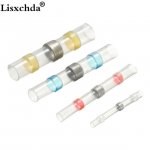JASinIL2006
Vice Admiral
- Joined
- Feb 10, 2012
- Messages
- 5,724
I'm getting ready to re-wire my single axle trailer. It is build with tube construction (2'x3" tube, I think) and one of my tasks is to drill holes in the side of the frame near the axles for my electric brake wires.
Currently the wires run inside the tubes from the tongue of the trailer all the way to the very back, where they exit. The wires then travel back to the axles in some thin tubing (hydraulic brake line tubing) that I clamped to the inside of the frame. I really don't like this set up, as the tubing takes a beating whenever I jack up the trailer or back it into an overgrown parking spot at out lake cabin.
I plan to drill holes into side of the frame, install rubber grommets to protect the wires, and to allow the wires to connect to the brakes.
My question: what do I need to drill through the frame? I've not tried drilling larger holes (I'm shooting for 1/4"-3/8" holes to give me clearance for the wires) into the frame. I'm assuming I start small (e.g., 1/8" drill bit) and work up, but is there any trick to it? Any special bits that make it easier? High speed drilling? Low speed? Is it better to drill dry or use some sort of cutting oil?
I'm assuming that one hole on each side of my trailer frame won't weaken it. Is that a safe assumption?
Thanks, as always, for your thoughts.
Jim
Currently the wires run inside the tubes from the tongue of the trailer all the way to the very back, where they exit. The wires then travel back to the axles in some thin tubing (hydraulic brake line tubing) that I clamped to the inside of the frame. I really don't like this set up, as the tubing takes a beating whenever I jack up the trailer or back it into an overgrown parking spot at out lake cabin.
I plan to drill holes into side of the frame, install rubber grommets to protect the wires, and to allow the wires to connect to the brakes.
My question: what do I need to drill through the frame? I've not tried drilling larger holes (I'm shooting for 1/4"-3/8" holes to give me clearance for the wires) into the frame. I'm assuming I start small (e.g., 1/8" drill bit) and work up, but is there any trick to it? Any special bits that make it easier? High speed drilling? Low speed? Is it better to drill dry or use some sort of cutting oil?
I'm assuming that one hole on each side of my trailer frame won't weaken it. Is that a safe assumption?
Thanks, as always, for your thoughts.
Jim




















